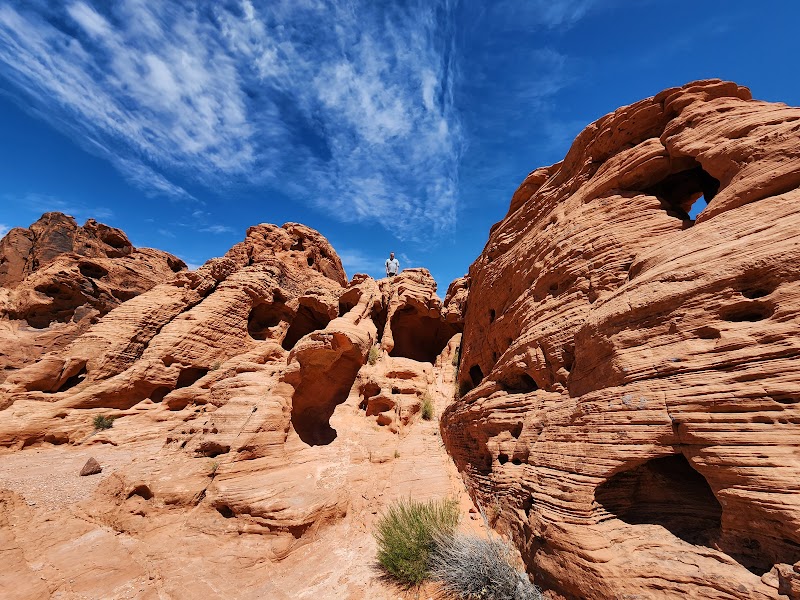Into the Inferno: Exploring the Remote Beauty of Valley of Fire State Park

In Nevada’s arid heart lies a place where the Earth refuses to play subtle. The Valley of Fire State Park doesn’t just exist—it commands your attention with its raw, elemental splendor. This is nature as spectacle, a landscape sculpted by time and tempest, where ancient sands pulse with molten hues of scarlet and amber under an unrelenting sun.
Reaching this desert sanctuary feels like slipping into a prehistoric fever dream. The jagged rock formations rise like a stone choir, their crimson peaks seeming to hum with the memory of oceans long gone. Arches curve like the ribs of ancient creatures, and petroglyphs etched millennia ago tell stories no language can fully translate. It’s a land of contrasts, where timeless beauty meets the dizzying impermanence of human life.
The Valley doesn’t reveal itself gently. It strikes like lightning, its intensity palpable in every gust of dry wind and every shimmering wave of desert heat. The horizon quivers like a mirage, distorting the boundaries between earth and sky. Trails like the White Domes loop and Fire Wave lure adventurers into this otherworldly expanse, offering paths that twist through narrow canyons and spill out onto vast, rippling dunes of stone.
At sunrise, the desert transforms into a living cathedral. The first light breaks over the horizon, washing the sandstone in liquid gold, igniting its fiery hues until the whole landscape glows as though lit from within. And then there’s night. Here, the dark is a velvety abyss studded with stars that pierce through the black canvas, their brilliance so immediate it feels personal. The silence is profound—a rare, weighty kind of quiet that seems to press against your skin and wrap around your thoughts.
The true magic of the Valley of Fire isn’t just in its staggering beauty—it’s in the way it forces you to surrender. Out here, under the vast desert sky, with nothing but sandstone and starlight, you feel small in the best way possible. You’re reminded of your place in the grand narrative of time, of the transient nature of human ambition, and of the enduring, breathtaking power of the Earth.
How to Explore the Valley of Fire
Exploring this fiery wonderland is as versatile as it is rewarding. The park’s 40,000 acres are crisscrossed with trails that range from leisurely strolls to demanding treks. Here are some must-see highlights:
- Fire Wave Trail: A 1.5-mile roundtrip hike that leads to a swirling, striped sandstone formation resembling a frozen wave of fire.
- White Domes Loop: A 1.25-mile trail through vibrant rock formations and a picturesque slot canyon, perfect for photographers.
- Mouse’s Tank Trail: A short, easy hike with ancient petroglyphs lining the way and a hidden waterhole at the end.
- Elephant Rock: An iconic rock formation that looks remarkably like its namesake, located just a short distance from the east entrance.
For a more immersive experience, consider camping overnight. The park has two well-maintained campgrounds with sites available on a first-come, first-served basis. Waking up to the desert’s quiet grandeur is an experience you won’t forget.
Who Is It Good For?
The Valley of Fire is a dream destination for nature lovers, hikers, photographers, and stargazers. It’s particularly well-suited for:
- Adventurous Families: Many trails are short and accessible, making it a great spot for kids to explore (with plenty of sunscreen and water, of course).
- Solo Travelers: The solitude and introspection offered by the park’s vastness are unmatched.
- Couples: Romantic sunsets and stargazing opportunities abound.
- Outdoor Enthusiasts: The dramatic landscapes are a playground for photographers, climbers, and hikers alike.
However, those who aren’t fans of extreme heat or rugged terrain might find the summer months challenging.
When to Visit
The best time to visit Valley of Fire is during the cooler months, from October to April. Temperatures range from the mid-50s to the low 80s, ideal for hiking and exploration. Summer, on the other hand, can be brutal, with daytime highs frequently exceeding 100°F. If you visit during the hotter months, start your activities early in the morning or late in the afternoon and always carry plenty of water.
For a special treat, plan your visit during sunrise or sunset. The interplay of light and shadow on the red rock formations is a spectacle that defies words.
How to Get There
The Valley of Fire is just an hour’s drive northeast of Las Vegas, making it an easy day trip or a convenient stop on a Southwest road trip. Here’s how to reach it:
- By Car: From Las Vegas, take Interstate 15 north to Exit 75, then follow the signs to the park’s west entrance. The drive is scenic and straightforward.
- By Tour: Guided tours are available from Las Vegas and often include hotel pickup, making them a great option for those without a vehicle.
Once inside, the park’s paved roads make it accessible for all vehicles, but a sturdy pair of hiking boots will take you to the places that roads cannot.
Practical Tips for Visitors
- Stay Hydrated: The desert heat is no joke, even in cooler months. Bring more water than you think you’ll need.
- Pack Smart: Sunscreen, hats, and lightweight, breathable clothing are must-haves.
- Timing Is Everything: Arrive early to beat the crowds and the heat.
- Respect the Landscape: Stay on marked trails to preserve the fragile desert ecosystem.
Final Thoughts
For those who crave adventure with a side of awe, the Valley of Fire isn’t just a destination—it’s a reckoning. Whether you’re marveling at the vivid sandstone waves or losing yourself under the star-splashed skies, this park promises an experience that’s equal parts humbling and exhilarating. So pack your sense of wonder and head into the inferno—you won’t leave unchanged.








